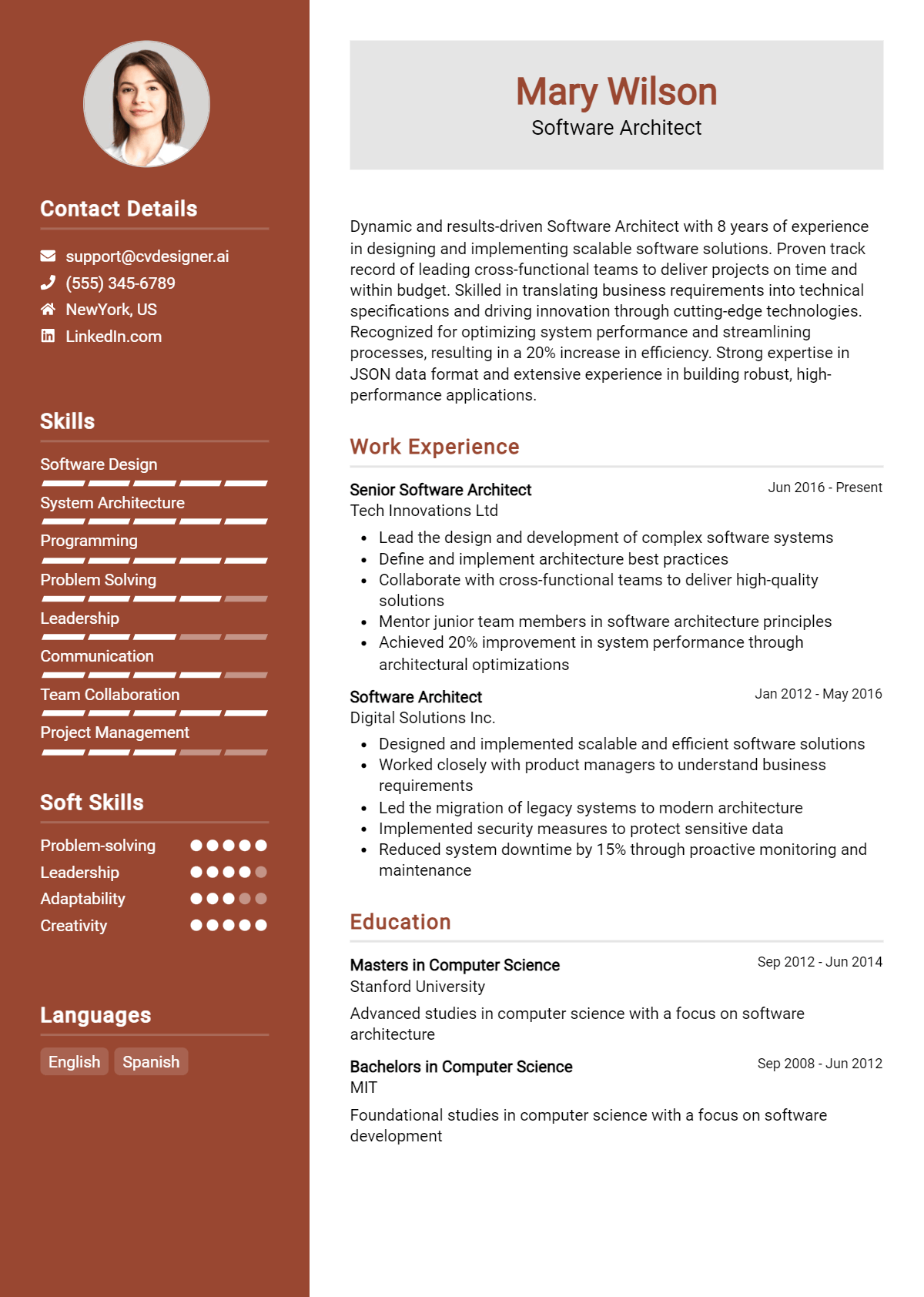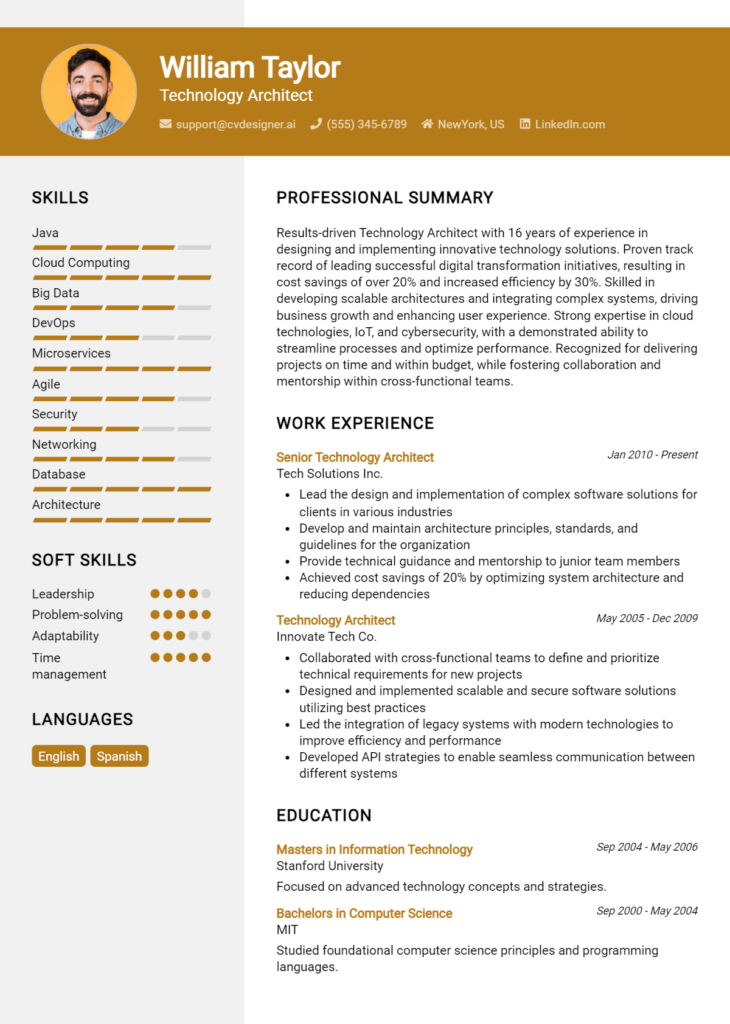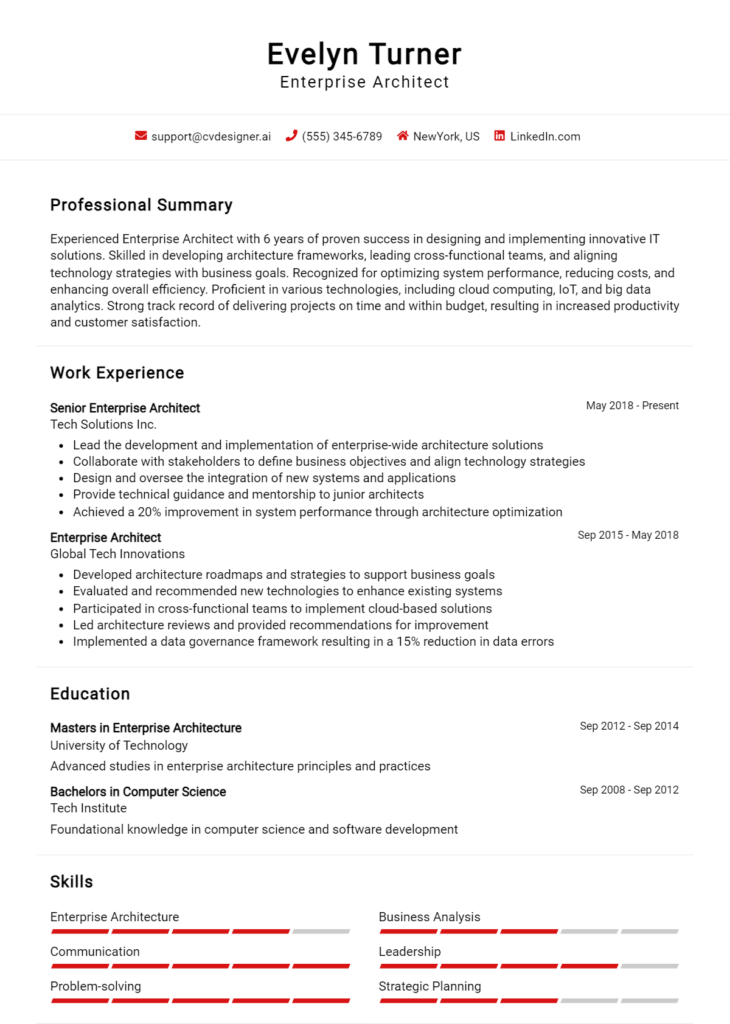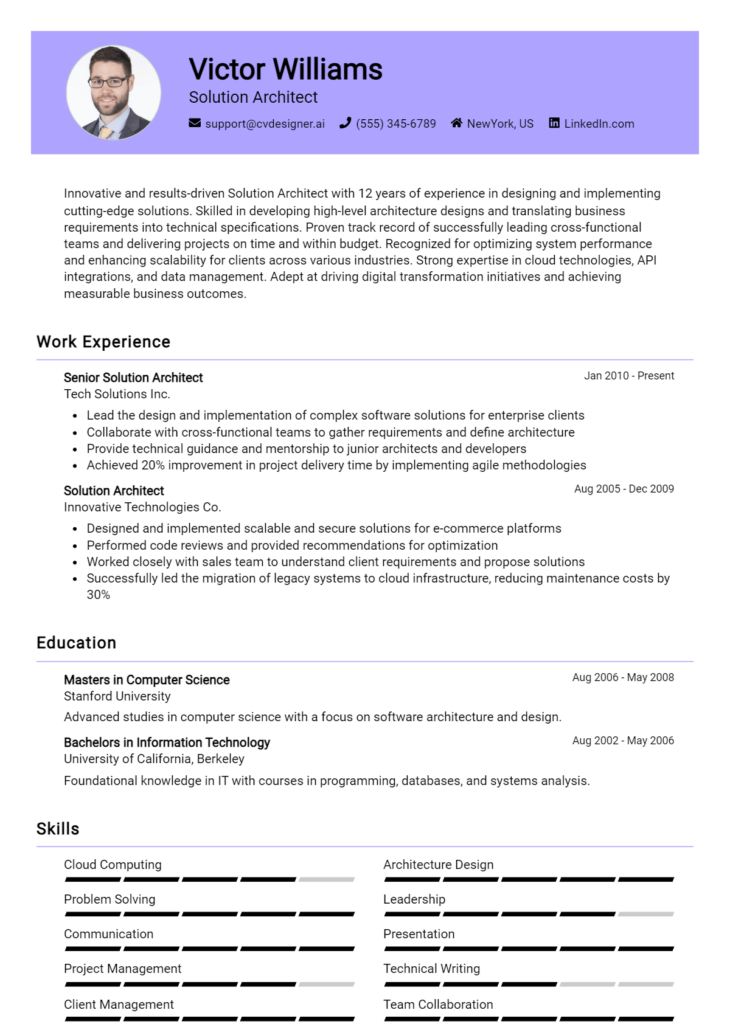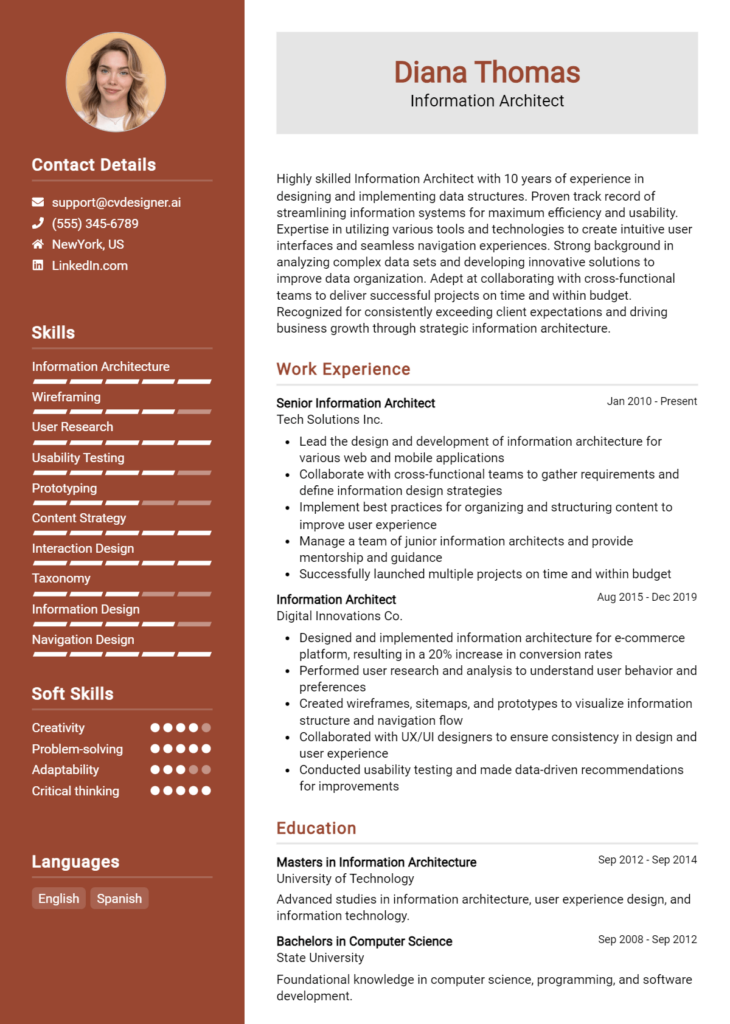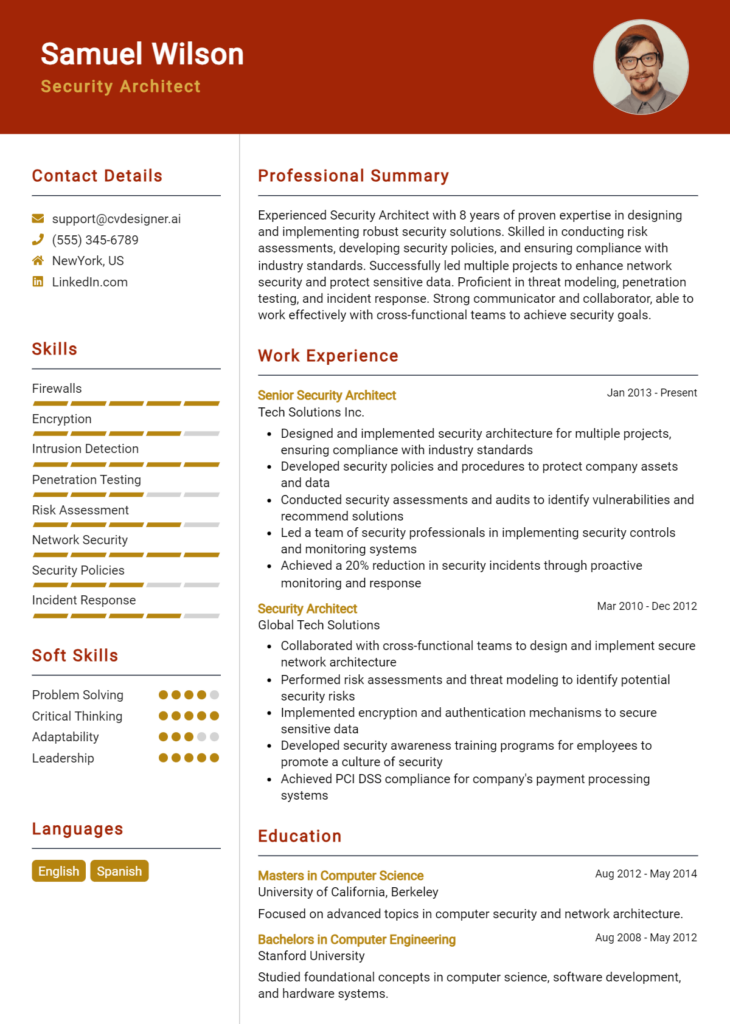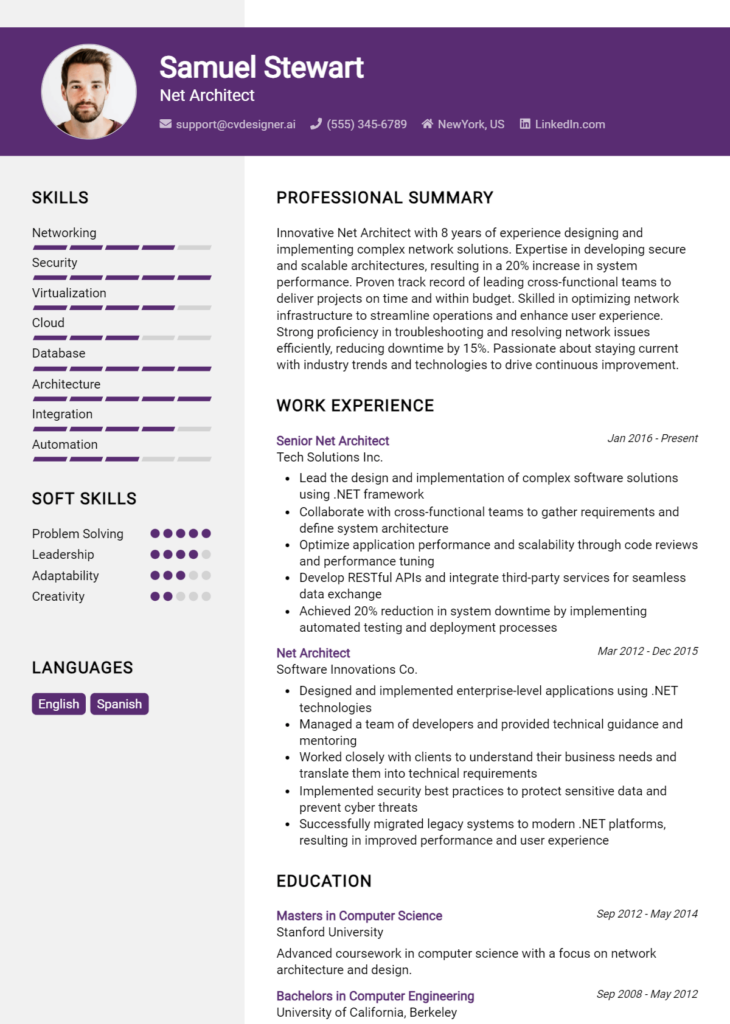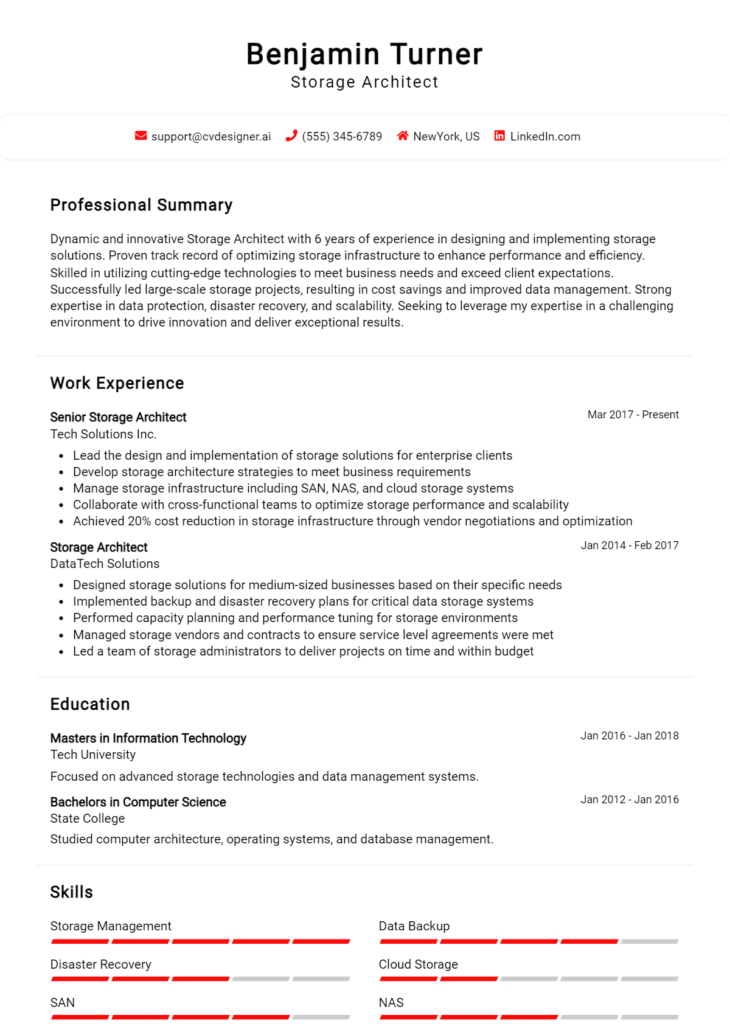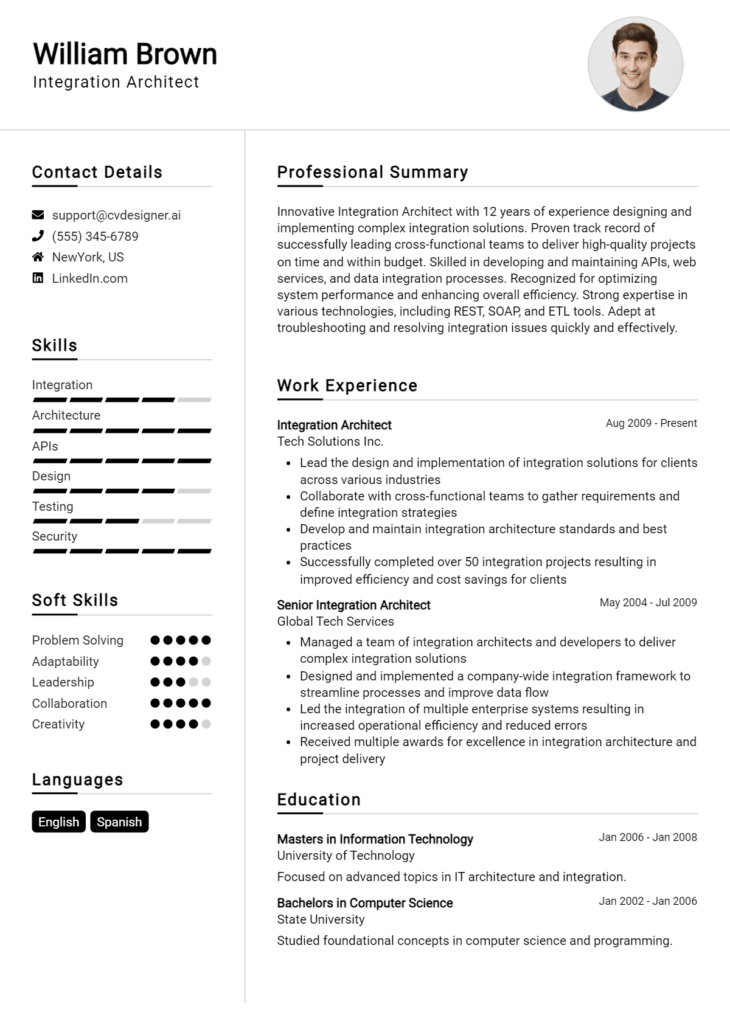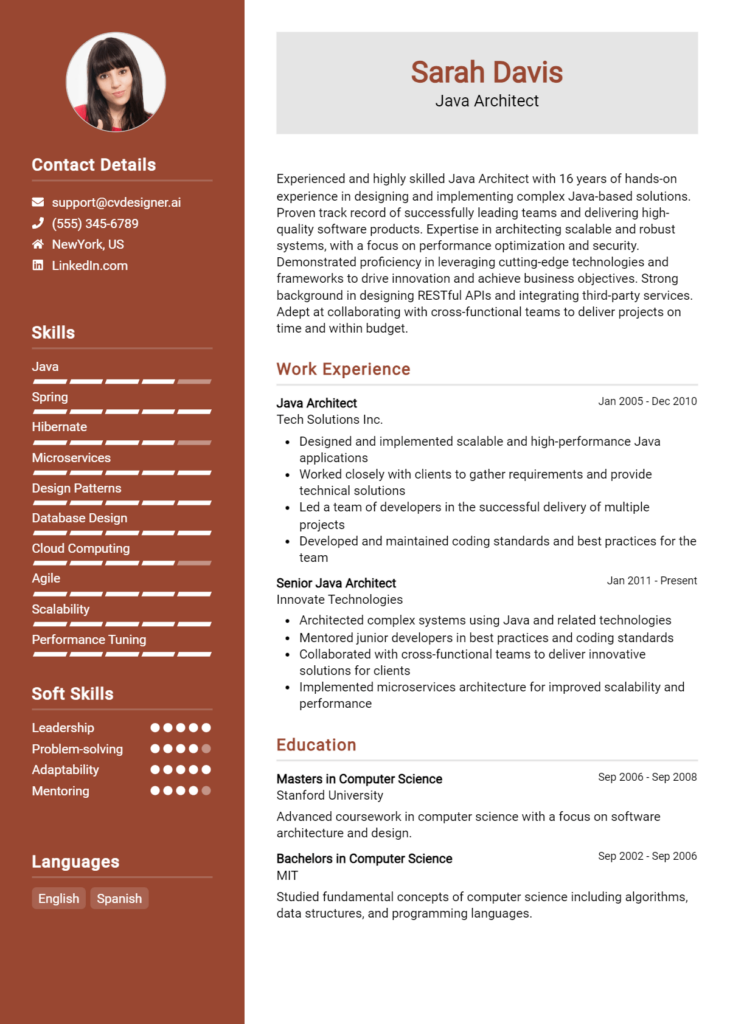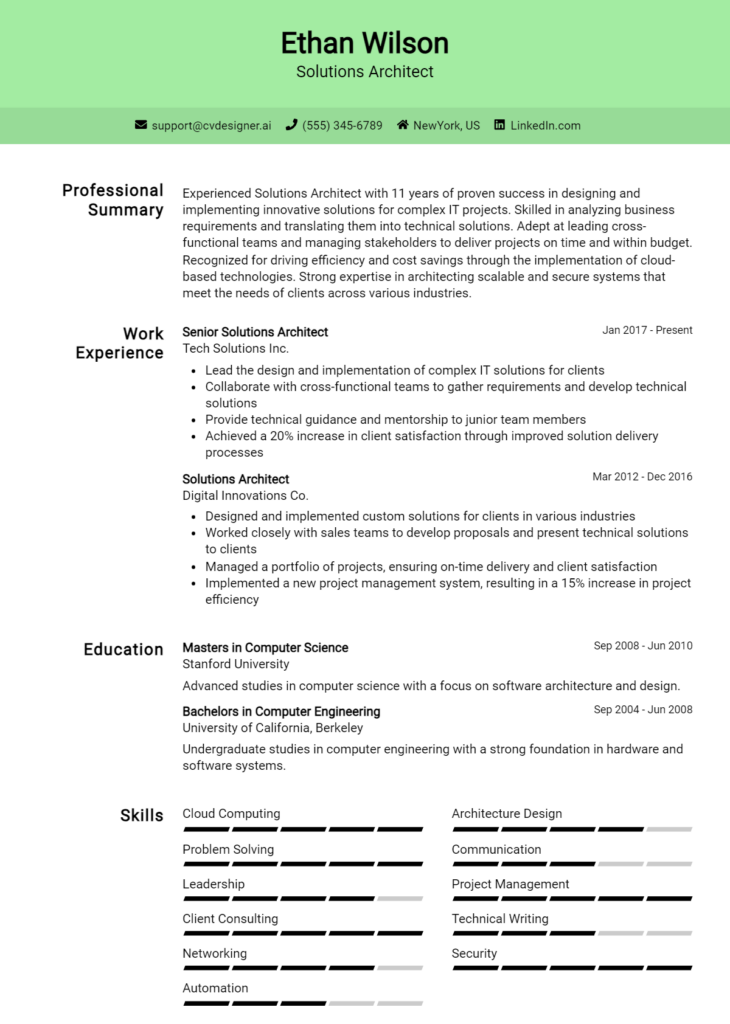Most Popular Software Architect Resume Examples
Explore additional Software Architect resume samples and guides and see what works for your level of experience or role.
As the backbone of any software development project, the Software Architect plays a pivotal role in designing and implementing robust software solutions that meet both technical and business requirements. This position demands not only a deep understanding of software engineering principles but also strong leadership and communication skills to guide teams through complex development processes. A well-crafted resume is essential for showcasing these skills and experiences, as it can set you apart in a competitive job market. In this article, we'll delve into the nuances of resume writing specifically tailored for Software Architects, ensuring you make a lasting impression on potential employers.
We'll explore key responsibilities and skills that every Software Architect should highlight, as well as the best resume formats to present your qualifications effectively. Additionally, we’ll discuss common mistakes to avoid that can undermine your application, and provide resume examples for all experience levels—from entry-level positions to seasoned professionals. You'll also find valuable tips on crafting impactful resumes, including how to select the right resume templates that align with your personal brand. Whether you're looking to refine your existing resume or create one from scratch, this guide will equip you with the tools you need for success.
Key Responsibilities and Skills for a Software Architect
A Software Architect plays a crucial role in the development and design of software systems. They are responsible for defining the technical architecture, making high-level design choices, and ensuring that the software meets both user needs and business goals. Their work involves collaborating with various stakeholders, including developers, project managers, and clients, to ensure the successful implementation of software projects.
Key Responsibilities:
- Design and document architectural solutions for complex software systems.
- Evaluate and select appropriate technologies and tools for projects.
- Lead technical design reviews and ensure adherence to software development standards.
- Collaborate with cross-functional teams to define project requirements and architecture.
- Address technical challenges and provide guidance to development teams.
- Perform code reviews and ensure quality assurance throughout the development lifecycle.
- Stay updated with industry trends and incorporate best practices into software designs.
Essential Skills:
- Proficiency in multiple programming languages (e.g., Java, C#, Python).
- Strong understanding of software development methodologies (e.g., Agile, Scrum).
- Experience with cloud computing platforms (e.g., AWS, Azure).
- Knowledge of database management and data modeling.
- Excellent problem-solving and analytical skills.
- Strong communication and interpersonal skills.
- Ability to translate technical concepts to non-technical stakeholders.
Highlighting these skills effectively in the resume skills section is paramount for standing out to potential employers. Tailoring these responsibilities and skills to the specific job description can significantly enhance your chances of being noticed. Additionally, consider how these skills could be relevant in creating a strong CV that showcases your expertise and aligns with the expectations of hiring managers in the software development field.
Best Resume Format and Structure for a Software Architect
When crafting a resume for a Software Architect position, it’s crucial to choose a format that highlights your skills and experiences effectively. The best resume format for a Software Architect typically follows a reverse-chronological structure, which allows hiring managers to easily see your most recent and relevant work experience at a glance. Here’s a detailed guide on the key sections to include in your resume:
Contact Information
Your resume should start with your contact information at the top. This section should include:
- Full Name
- Phone Number
- Professional Email Address
- LinkedIn Profile URL (optional but recommended)
- GitHub or personal portfolio link (if applicable)
- Location (City, State)
Professional Summary
The professional summary is a brief section that provides an overview of your qualifications and experience. Aim for 3-5 sentences that encapsulate:
- Your years of experience in software architecture
- Key technologies and methodologies you are proficient in (e.g., microservices, cloud architecture)
- Your biggest achievements or contributions in previous roles
- Your career objectives and what you bring to the prospective employer
Work Experience
This section should include your relevant work history in reverse chronological order. Each entry should contain:
- Job Title
- Company Name and Location
- Dates of Employment (Month/Year)
- Bullet points detailing your responsibilities, achievements, and the technologies you worked with. Focus on quantifiable results, such as:
- Successfully led a project that increased system efficiency by 30%
- Designed and implemented a cloud-based solution that reduced operational costs by 20%
Make sure to tailor this section to reflect the skills and experiences that are most relevant to the Software Architect role.
Education
List your educational background, starting with the most recent degree. Include:
- Degree Title (e.g., Bachelor of Science in Computer Science)
- University Name and Location
- Graduation Date (Month/Year)
- Relevant coursework, honors, or extracurricular activities that demonstrate your capabilities in software architecture (if applicable).
Skills
Include a dedicated skills section that highlights both technical and soft skills relevant to the Software Architect role. List skills such as:
- Programming languages (e.g., Java, C#, Python)
- Frameworks and tools (e.g., AWS, Docker, Kubernetes)
- Architecture design patterns
- Agile methodologies
- Communication, leadership, and problem-solving skills
Certifications
If you hold relevant certifications, create a section to showcase these credentials. Examples include:
- AWS Certified Solutions Architect
- Certified ScrumMaster (CSM)
- TOGAF Certified Architect
- Microsoft Certified: Azure Solutions Architect Expert
Additional Tips
- Tailor the Content: Customize your resume for each job application by including keywords from the job description.
- Keep it Concise: Aim for a 1-2 page resume, focusing on the most relevant experiences and skills.
- Use Action Verbs: Start bullet points with action verbs to convey your impact (e.g., Designed, Developed, Led).
- Format Consistently: Use a clean, professional font and ensure consistent formatting throughout (e.g., bullet points, spacing, font sizes).
The format of your resume should complement your cover letter. Just as your resume provides a snapshot of your qualifications, your cover letter can expand on your experiences and showcase your personality. Use the same design elements (like header style and font) in both documents to maintain a cohesive professional appearance. Your cover letter should elaborate on specific projects or experiences mentioned in your resume, providing a narrative that connects your skills to the job you’re applying for.
By following this structured approach, you can create a compelling resume that effectively showcases your qualifications as a Software Architect, helping you stand out in a competitive job market.
Writing Tips and Best Practices for a Software Architect Resume
When crafting a resume as a Software Architect, it’s vital to present your skills and experiences in a clear and compelling manner. Focus on showcasing your technical expertise, leadership abilities, and successful project outcomes. Ensure your resume is tailored to the specific job you’re applying for, emphasizing relevant experience and skills that align with the potential employer's needs. Utilizing resume writing tips can help you achieve a polished and professional look, making a strong first impression. Remember that these practices are equally important when drafting a cover letter, as both documents serve to highlight your qualifications effectively.
- Use strong action verbs to begin bullet points, such as "designed," "implemented," or "led," to convey your contributions assertively.
- Quantify your achievements whenever possible, such as stating "increased system efficiency by 30%" to provide tangible evidence of your impact.
- Incorporate industry-specific keywords and phrases that align with the job description to help your resume pass through Applicant Tracking Systems (ATS).
- Highlight relevant certifications or technologies that demonstrate your expertise, such as cloud platforms, programming languages, or architectural methodologies.
- Structure your resume clearly with distinct sections for skills, experience, education, and certifications to enhance readability.
- Keep your resume to a maximum of two pages to ensure that only the most relevant information is presented succinctly.
- Tailor your resume for each application by adjusting the content to reflect the specific skills and experiences that match the job requirements.
- Use bullet points for clarity and brevity, making it easier for hiring managers to scan your qualifications quickly.
Common Mistakes to Avoid in a Software Architect Resume
When crafting a resume for a Software Architect position, it’s crucial to present your skills and experience effectively to stand out in a competitive field. However, many candidates fall into common pitfalls that can undermine their chances of landing an interview. By avoiding these mistakes, you can create a more compelling resume that showcases your qualifications and expertise.
- Overloading the resume with unnecessary information or jargon that may confuse the reader.
- Using generic descriptions that fail to highlight specific accomplishments or contributions.
- Failing to tailor your resume to the specific job description, missing out on relevant keywords.
- Neglecting to showcase both technical skills and soft skills, which are vital for a Software Architect role.
- Listing responsibilities instead of achievements, diminishing the impact of your experience.
- Ignoring the importance of a clean, organized layout, making it difficult for hiring managers to navigate.
- Using an outdated format or design that doesn’t align with modern resume trends.
- Omitting quantifiable results or metrics that demonstrate the impact of your work.
- Not including relevant certifications or continuous education efforts that reflect your commitment to growth.
- Forgetting to proofread for spelling and grammatical errors, which can detract from professionalism.
For a more comprehensive understanding of these pitfalls, consider reviewing common mistakes to avoid in a resume. Additionally, don’t overlook the importance of crafting a strong cover letter; similar mistakes can occur there as well, so be sure to check out common cover letter mistakes to ensure your entire application is polished and professional.
Sample Software Architect Resumes
As a Software Architect, the role requires not only a deep understanding of software development but also the ability to design robust systems, lead technical teams, and communicate effectively with stakeholders. Below are three sample resumes tailored for distinct career stages: an experienced professional, an entry-level candidate, and a career changer. Each resume highlights key skills and experiences relevant to the Software Architect position.
Sample Resume 1: Experienced Software Architect
John Doe
[City, State] | [Phone Number] | [Email Address]
Professional Summary
Results-driven Software Architect with over 10 years of experience in designing scalable applications and leading diverse development teams. Proven track record in implementing best practices, optimizing processes, and delivering high-quality software solutions on time and within budget.
Technical Skills
- Architecture Design: Microservices, SOA, Event-Driven Architecture
- Programming Languages: Java, C#, Python, JavaScript
- Frameworks: Spring, .NET, Angular, React
- Cloud Platforms: AWS, Azure, Google Cloud
- Tools: Docker, Kubernetes, Jenkins, Git
Professional Experience
Senior Software Architect
XYZ Corporation, [City, State]
January 2018 - Present
- Led a team of 15 developers in designing and implementing a microservices architecture for a high-traffic e-commerce platform, resulting in a 30% increase in performance and scalability.
- Collaborated with stakeholders to gather requirements and translate them into technical specifications, ensuring alignment with business objectives.
- Conducted code reviews and integrated testing procedures to ensure adherence to coding standards and best practices.
Software Architect
ABC Technologies, [City, State]
June 2014 - December 2017
- Developed architectural frameworks and standards for a suite of enterprise applications, enhancing maintainability and reducing time to market by 25%.
- Spearheaded the migration of legacy systems to cloud-based solutions, improving system reliability and reducing operational costs by 20%.
- Mentored junior developers and conducted training sessions on new technologies and architecture principles.
Education
Bachelor of Science in Computer Science
University of Technology, [City, State]
Graduated: May 2011
Sample Resume 2: Entry-Level Software Architect
Jane Smith
[City, State] | [Phone Number] | [Email Address]
Professional Summary
Motivated and detail-oriented recent graduate with a degree in Computer Science and a strong foundation in software development principles. Eager to leverage academic knowledge and internship experience to contribute as a Software Architect in a dynamic team environment.
Technical Skills
- Programming Languages: Java, Python, JavaScript
- Frameworks: Spring Boot, React
- Databases: MySQL, MongoDB
- Tools: Git, Docker
Education
Bachelor of Science in Computer Science
University of Technology, [City, State]
Graduated: May 2023
Internship Experience
Software Development Intern
Tech Innovations, [City, State]
June 2022 - August 2022
- Assisted in designing and developing a web application using React and Node.js, collaborating closely with senior architects to ensure best practices in software design.
- Participated in daily stand-up meetings and contributed to agile development processes, enhancing team communication and project efficiency.
- Conducted testing and debugging of software components, improving overall application performance by identifying and resolving issues early in the development cycle.
Projects
- Capstone Project: Developed a mobile application for task management, utilizing Flutter and Firebase, which received positive feedback from peers and faculty for its user-friendly design and functionality.
Sample Resume 3: Career Changer to Software Architect
Michael Johnson
[City, State] | [Phone Number] | [Email Address]
Professional Summary
Detail-oriented professional with 7 years of experience in project management and a passion for software development. Recently completed a Software Engineering bootcamp, gaining hands-on experience in full-stack development and architectural design. Seeking to transition into a Software Architect role to leverage both technical and managerial skills.
Technical Skills
- Programming Languages: Java, Ruby, JavaScript
- Frameworks: Ruby on Rails, Angular
- Databases: PostgreSQL, MongoDB
- Tools: Git, Jenkins
Education
Software Engineering Bootcamp
Coding Academy, [City, State]
Completed: August 2023
Professional Experience
Project Manager
Global Solutions, [City, State]
January 2016 - July 2023
- Managed cross-functional teams to deliver complex projects on time and within budget, fostering a collaborative environment and ensuring stakeholder satisfaction.
- Analyzed project requirements and collaborated with technical teams to develop project plans, highlighting the importance of software architecture in project success.
Software Engineering Projects
- E-commerce Website: Designed and implemented a fully functional e-commerce platform using Ruby on Rails, focusing on user experience and scalability.
- Personal Portfolio Site: Developed a personal portfolio website using HTML, CSS, and JavaScript to showcase projects and skills.
Explore more resume templates for inspiration to create a standout application. Don’t forget to pair your resume with corresponding cover letter examples to complete your job application package.
Checklist for a Software Architect Resume
- Proofread for Errors: Carefully check for spelling, grammar, and punctuation mistakes. Consider reading your resume aloud or using a tool to catch errors you might overlook.
- Ensure Consistency: Verify that formatting, font sizes, and styles are consistent throughout the document. This includes ensuring headers, bullet points, and spacing are uniform.
- Tailor to the Job Description: Customize your resume for each job application by incorporating keywords and phrases from the job description to highlight your relevant experience.
- Highlight Relevant Experience: Ensure that your work experience focuses on roles and projects that are directly related to software architecture, emphasizing your accomplishments and outcomes.
- Showcase Technical Skills: Clearly list programming languages, frameworks, and tools you are proficient in, ensuring they align with the requirements of the position you are applying for.
- Include Certifications and Education: List any relevant certifications, degrees, or courses that enhance your qualifications as a software architect.
- Utilize Action Verbs: Start bullet points with strong action verbs to convey your contributions and achievements effectively, such as "designed," "implemented," or "led."
- Add a Summary Statement: Incorporate a brief summary at the top of your resume that outlines your professional background and key skills, tailored to the software architect role.
- Seek Feedback: Consider having a peer or mentor review your resume to provide constructive feedback and identify any areas for improvement.
- Use an AI Resume Builder: To ensure all elements are well-organized and visually appealing, consider utilizing an AI resume builder that can help streamline the process.
A similar checklist can be followed for creating a CV or cover letter to ensure they are polished and effective.
Key Takeaways for a Software Architect Resume Guide
In conclusion, your resume as a Software Architect is a critical tool that can set you apart in a competitive job market. By leveraging the examples and tips provided in this guide, you can craft a compelling resume that effectively showcases your skills, experiences, and achievements. Don’t forget to explore additional resources, such as downloading a template from resume templates or a cover letter template, to further enhance your application materials. You might also consider utilizing our best resume maker for a polished presentation. Remember, adhering to similar guidelines will also aid you in developing an impressive CV and cover letter that resonate with potential employers. Take the next step in your career journey by creating a standout resume that reflects your expertise and passion for software architecture!
